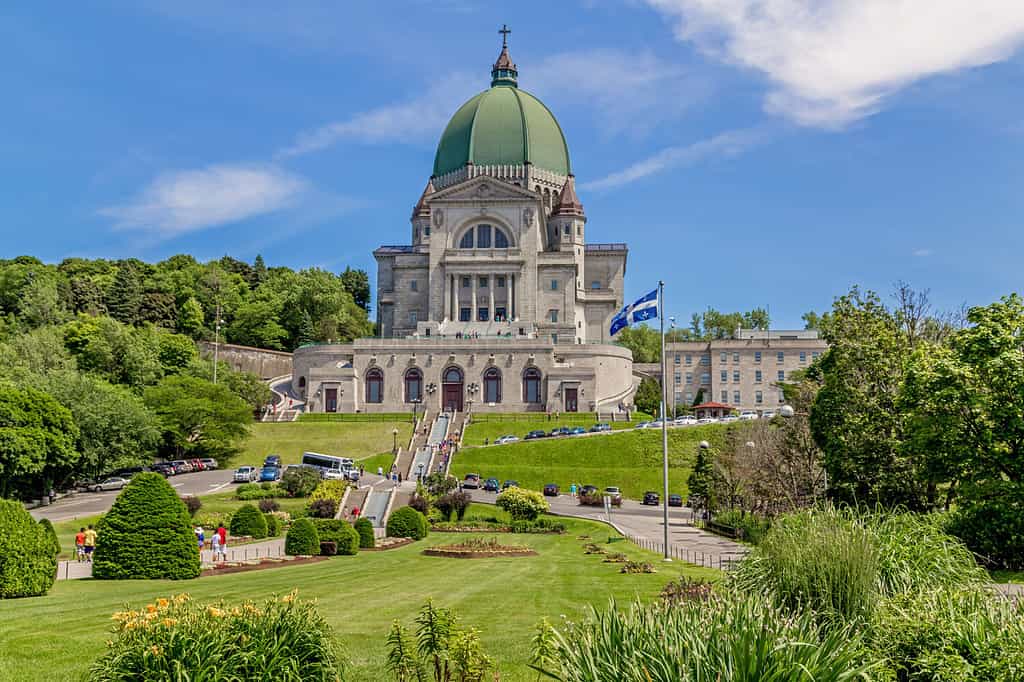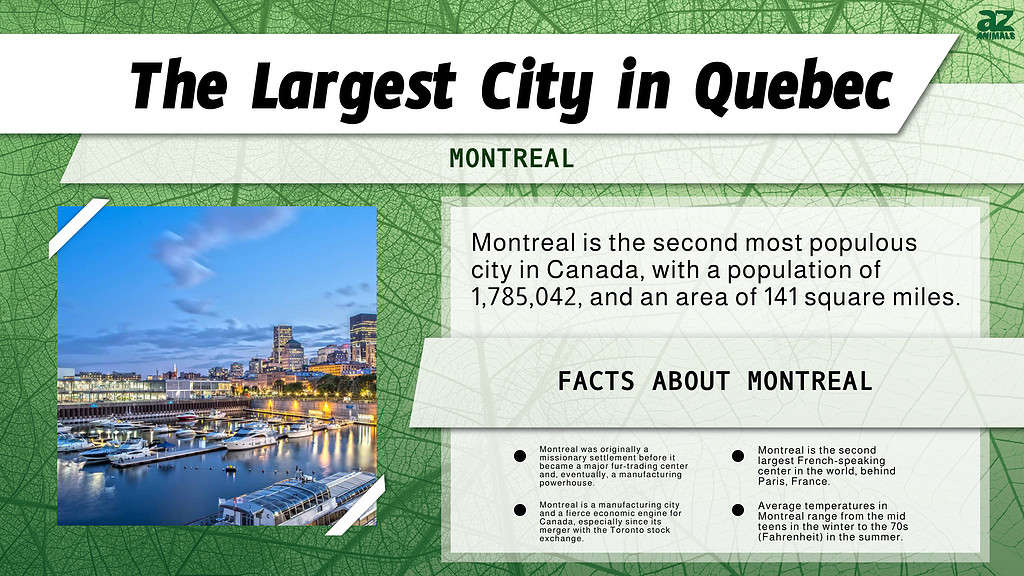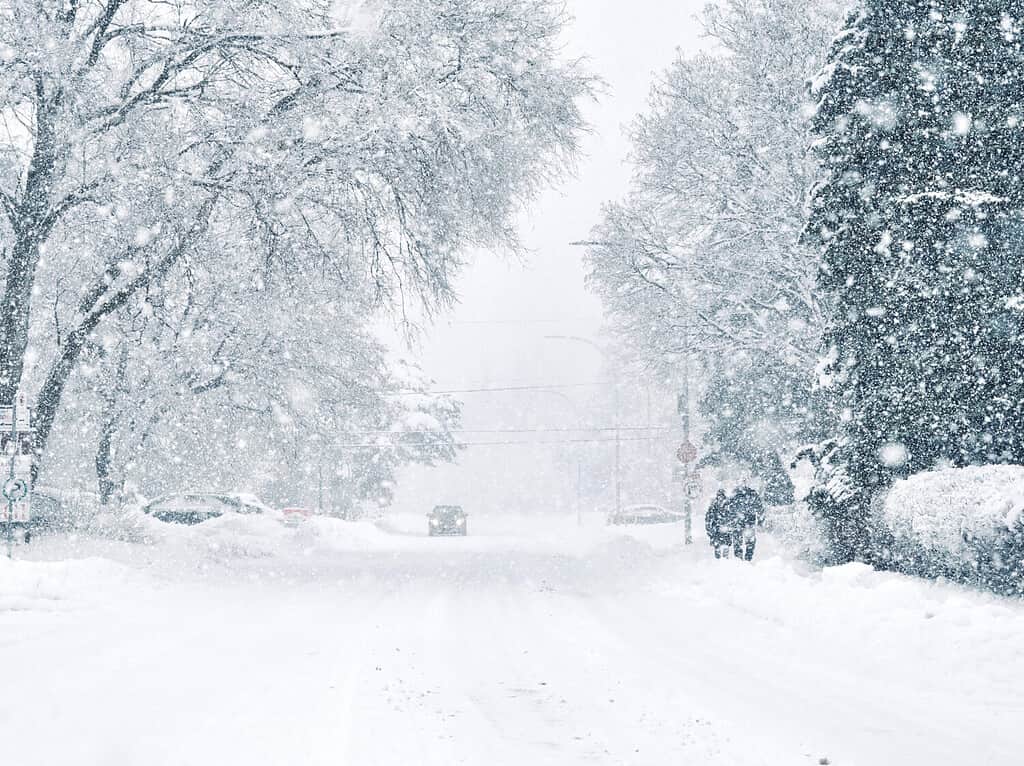As the largest city in Quebec, Montreal isn’t taking on any challenges to its population size anytime soon. Quebec itself is the largest province in all of Canada, with the vast majority of its population in the bottom half of the state. One fact that may surprise those on the outside looking in, is that Quebec is a French-speaking province.
It’s the only one of its kind in North America. Though Quebec is the largest province, it’s not the largest in terms of population. That award goes to Ontario. Montreal is a coastal town, thanks to the foresight of original settlers seeking a place that provides rich land for farming.
Looking at the population density in the area, the original settlers chose an excellent place. The vast majority of Quebec’s population resides along the St. Lawrence River. Montreal is as European as it gets in North America, only falling behind Paris as the largest French-speaking city in the world.
The Largest City in Quebec

The largest church in Canada, Saint Joseph’s Oratory, is located in Montreal.
©Hakat/Shutterstock.com
Montreal is the largest city in Quebec, and It’s not even a close thing. Its 2023 population, according to the World Population Review, sits at 1,785,042. The next closest city, in terms of population only, is Quebec City, which is far behind Montreal with only a little over half a million.
It doesn’t seem likely that Quebec City will overtake Montreal in the next 30 years, with the growth rate in Quebec City being lower than Montreal’s. You have to jump way down the list to find the fastest-growing city in the province, which is Saint Colomban at 4.14%.
Unfortunately, for Saint Colomban’s prospects of one day overtaking Montreal, there are only 21,275 people currently residing there. It seems likely that the largest city in Quebec will still be the largest 30 years from now. Thanks to the Saint Lawrence River, Montreal owes its existence to fur trading and, later, a manufacturing powerhouse with a major advantage in the transportation of goods.
With that kind of economic history and the proximity of an abundance of natural resources, it’s little wonder that Montreal is the largest city in Quebec.
Montreal Statistics and Economics

The city of Montreal is bilingual but still thought of as the New France of North America, thanks to its French roots and most residents primarily speaking French. Thanks to transportation and manufacturing advantages, geographically and culturally, Montreal is the nucleus of Canada’s aerospace industry, as well as other tech-leaning industries.
IATA (International Air Transport Association) is at home in Montreal, however, the city is also involved in research and development, transportation technology, software, telecommunications, printing, food processing, and pharmaceuticals.
Unfortunately, Montreal also has a historically separatist mentality, which drove a lot of major businesses out of Montreal back in the 70s. If those businesses and their industries were still in Montreal today, it would have a much better chance of being the economic hub for all of Canada. Montreal has a deep and interesting history, especially in its relationship with Canada.
What Attracts People To Montreal?
Don’t let the northern climate fool you. The largest city in Quebec gets plenty from the tourism industry, and many people flock there throughout the year for the various job opportunities in the tech industry. Immigration is a large factor as well. Quebec brings in roughly 30k to 50k immigrants per year, many of whom make their way to Montreal in short order.
Old Montreal is the biggest tourism draw in the city. Old Montreal is where all of the history is, and its unique look, with cobblestone streets and old European architecture, is both beautiful and attractive for visitors to the city.
Montreal is also known for its fine dining, especially if you’re a big fan of bagels. Between Old Montreal and the numerous festivals that take place throughout the year, Montreal draws millions of tourists to the city on an annual basis.
Climate In The Largest City In Quebec

The climate can get a bit chilly in Montreal.
©HeyDebbie/Shutterstock.com
For Southerners (which is everyone south of the border to Canadians), the thought of living in Canada may sound a bit frigid. And it does get cold in Montreal. The northern part of the province of Quebec is essentially an arctic tundra, where very few live.
However, Montreal didn’t become the largest city in Quebec because no one wanted to deal with the cold weather. The average temperatures throughout the year run from the mid-teens in the winter to the 70s in the summer. In life almost everywhere on the planet, there are days when the temps drop into the single digits and sub-zero, especially when it comes to the wind chill.
There are also days in the summer when temperatures climb well above the 70s. For the most part, the temps are not as extreme as Montreal’s geographical location implies. This is especially true if you move to the region and become acclimatized to the weather. After all, those in Montreal deal with it every day, just fine.
Government in Montreal
There are 19 boroughs in the city of Montreal, and each one has its council. Each council has a single councilor who represents the borough among 65 other councilors from the other boroughs. The mayor of Montreal is the head of the 65 councils representing their respective boroughs.
There are an additional 15 municipalities that are not incorporated with the city. However, these municipalities remain strongly involved in the city’s politics and governorship. Think of them as suburbs to a city like Atlanta.
What Will Be The Largest City In Quebec In 30 Years?
| Ranking | City | Population | Population Growth | Size | Median Income |
|---|---|---|---|---|---|
| #1 | Montreal | 1,785,042 | .66% | 166.6 mi² | $82.5k |
| #2 | Quebec City | 554,125 | .59% | 187.6 mi ² | $63.2k |
| #3 | Laval | 454,946 | 1.05% | 103 mi² | $73.5k |
| #4 | Gatineau | 292,255 | .81% | 147 mi² | $82.6k |
| #5 | Longueuil | 251,809 | .71% | 119.3 mi² | $71k |
In all likelihood, the largest city in Quebec, after thirty years pass, will remain Montreal. Though there are other cities with substantial growth rates in the province of Quebec, they are so far behind Montreal in population numbers that it would take a hundred years, with sustained and accelerated population growth, to overtake Montreal.
Of course, that doesn’t take into account the fact that demographics change annually, and what is 4% growth today may turn into 2% growth tomorrow. The next closest city, in terms of population size, is Quebec City, and it only has a population that’s half that of Quebec.
Laval is the third-largest city in Quebec, with a population growth of 1.05% and a current population of 454,946. That’s only a shade over 25% of the population of Montreal, which itself has a population growth of .66%. The fourth-largest city (Gatineau) is a significant drop from Laval, with a population of 292,255 and a population growth of .81%.
The fifth-largest city, Longueuil, is roughly on par with Gatineau, with a population of 251,809 and a growth rate of .71%. The fastest-growing cities include Vaudreuil-Dorion (2.74%), Chambly (2.63%), Saint Lin-Laurentides (3.55%), Sainte-Marthe-Sur-Le-Lac (2.87%), and Saint Colomban (4.14%). However, the most populated city, of the fastest-growing list, only has 44,044 people.
In other words, Montreal’s status as the largest city in Quebec isn’t likely to face a challenge for that title anytime soon.
The photo featured at the top of this post is © Lewis Tse/Shutterstock.com
Thank you for reading! Have some feedback for us? Contact the AZ Animals editorial team.







